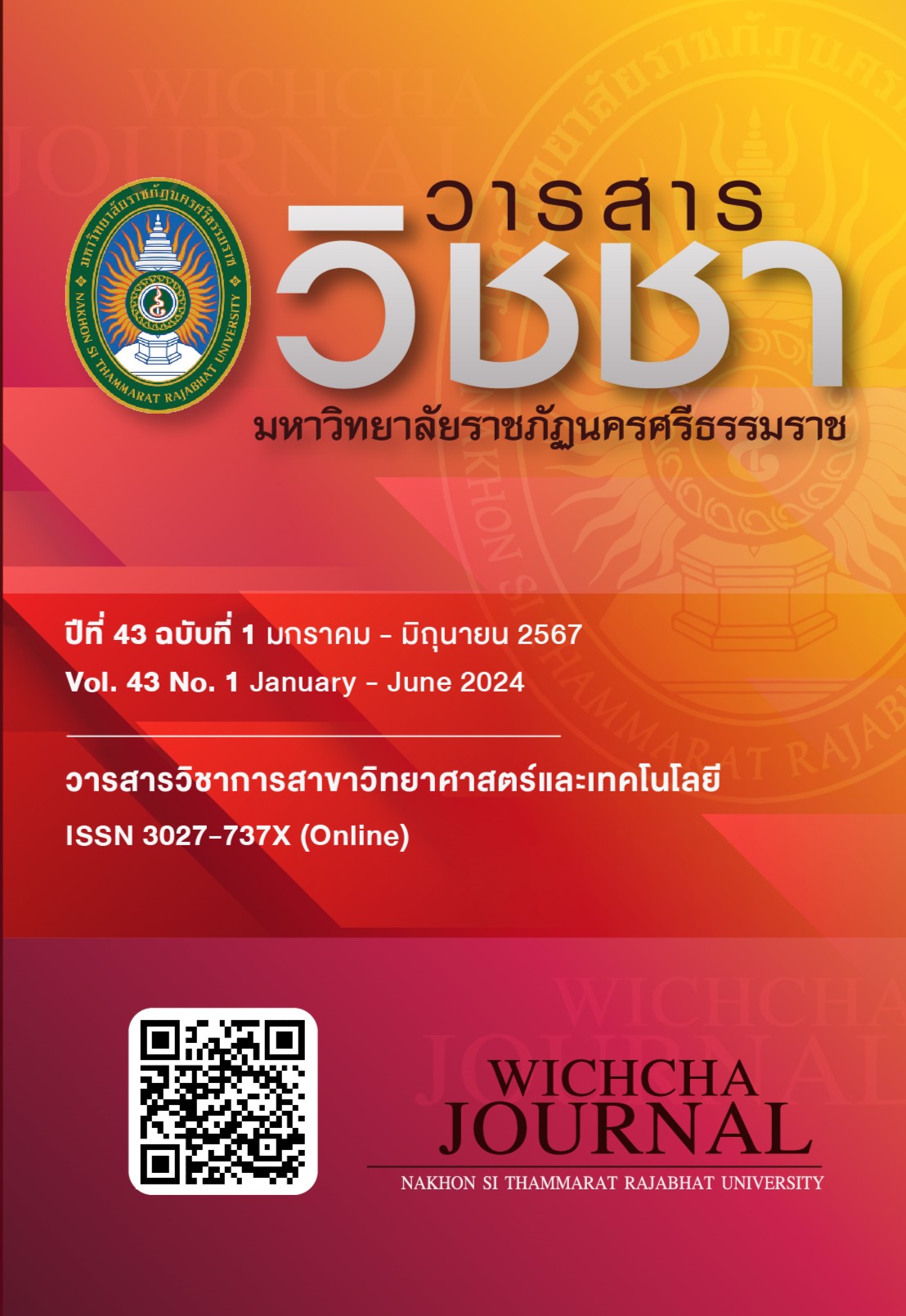Effect of Using Manure and Biochar from Rice Straw on Growth and Yield of Green Oak (Lactuca sativa L.)
Main Article Content
Abstract
This research aimed to study the appropriate ratio of manure and biochar in the growth and yield of Green Oak. The field experiment had been done at Na Sai Subdistrict Child Development Center Mueang district, Nakhon Si Thammarat province from September 2021 to January 2022. The complete randomized design (CRD) was adopted which resulted in 4 different treatments: (T1) no application of biochar and manure, (T2) manure only (2,000 kilogram (kg) per rai), (T3) biochar combined with manure (1500:500 kg/rai), and (T4) biochar combined with manure (500:1500 kg/rai). The result showed that the use of manure and biochar in different ratios after being transplanted for 40 days had a statistically significant (p ≤ 0.01). With T2, the parameters of stem diameter, plant height, canopy root length, and. the fresh weight per plant was higher than those of other treatments, at 28.12 centimeter (cm), 43.38 cm, 69.25 cm, 50.38 cm, and 189.57 gram per plant, respectively. It can be concluded that the use of chemical fertilizer can be replaced by the use of biochar combined with manure at the rate of 500:1500 kg/rai in growing Green Oak.
Article Details

This work is licensed under a Creative Commons Attribution-NonCommercial-NoDerivatives 4.0 International License.
เนื้อหาและข้อมูลในบทความที่ลงตีพิมพ์ในวารสารวิชชา มหาวิทยาลัยราชภัฏนครศรีธรรมราช ถือเป็นข้อคิดเห็นและความรับผิดชอบของผู้เขียนบทความโดยตรง ซึ่งกองบรรณาธิการวารสารไม่จำเป็นต้องเห็นด้วยหรือร่วมรับผิดชอบใด ๆ
บทความ ข้อมูล เนื้อหา รูปภาพ ฯลฯ ที่ได้รับการตีพิมพ์ในวารสารวิชชา มหาวิทยาลัยราชภัฏนครศรีธรรมราช ถือเป็นลิขสิทธ์ของวารสารวิชชา มหาวิทยาลัยราชภัฏนครศรีธรรมราช หากบุคคลหรือหน่วยงานใดต้องการนำข้อมูลทั้งหมดหรือส่วนหนึ่งส่วนใดไปเผยแพร่ต่อหรือเพื่อการกระทำการใด ๆ จะต้องได้รับอนุญาตเป็นลายลักษณ์อักษรจากวารสารวิชชา มหาวิทยาลัยราชภัฏนครศรีธรรมราชก่อนเท่านั้น
The content and information in the article published in Wichcha journal Nakhon Si Thammarat Rajabhat University, It is the opinion and responsibility of the author of the article. The editorial journals do not need to agree. Or share any responsibility.
References
เกศศิรินทร์ แสงมณี ชัยนาม ดิสถาพร และสุรชัย สุวรรณชาติ. (2557). การจัดการดินด้วยเทคโนโลยีชีวภาพและถ่านชีวภาพในการผลิตผักคะน้าในดินทราย. ใน การประชุมวิชาการและนำเสนองานวิจัยพืชเขตร้อนและกึ่งร้อน ครั้งที่ 8 (หน้า 70). กรุงเทพฯ: มหาวิทยาลัยหอการค้า.
เกศศิรินทร์ แสงมณี ธีระรัตน์ ชิณแสน และณัฐพงษ์ พันธุภา. (2558). ผลของการใช้แหนแดง ปุ๋ยคอก และปุ๋ยเคมี ต่อการเจริญเติบโตและผลผลิตของข้าวพันธุ์ไข่มดริ้น. ใน การประชุมทางวิชาการของมหาวิทยาลัยเกษตรศาสตร์ ครั้งที่ 53 (หน้า 746-752). กรุงเทพฯ: มหาวิทยาลัย เกษตรศาสตร์.
ฉัตรชัย กิตติไพศาล. (2547). ผลของไนโตรเจนที่ใช้โดยเกษตรกรต่อผลผลิตและประสิทธิภาพการใช้ไนโตรเจนของผักกวางตุ้ง. วิทยานิพนธ์วิทยาศาสตรมหาบัณฑิต. มหาวิทยาลัยสงขลานครินทร์, สงขลา.
ช่อทิพย์ อังศุนิตย์ลาภา คริษฐ์สพล หนูพรหม และอมรรัตน์ ชุมทอง. (2559). ผลของตาข่ายพรางแสงต่อการเจริญเติบโตและผลผลิตของผักกาดกวางตุ้งในฤดูแล้งของจังหวัดสงขลา ใน การประชุมวิชาการระดับชาติราชภัฎเพชรบุรีเพื่อแผ่นดินไทยที่ยั่งยืน ครั้งที่ 6 (หน้า 888-893). เพชรบุรี: มหาวิทยาลัยราชภัฎเพชรบุรี.
นัฐวุฒิ เพ็ชรชาติ พิมพ์ชนก ธาตรีวิจิตร หนึ่งหทัย ธราพร ศราวุฒิ ชูโลก และนวรัตน์ สีตะพงษ์. (2566). สมบัติการเป็นเชื้อเพลิงของชีวมวลอัดแท่งและถ่านชีวมวลอัดแท่งจากเปลือกกระท้อนและเปลือกมังคุด. วารสารวิชชา มหาวิทยาลัยราชภัฏนครศรีธรรมราช, 42(1), 39-49.
พินิจภณ ปิตุยะ และอนัญญา โพธิ์ประดิษฐ์. (2560). การพัฒนาและฟื้นฟูดินทรายในเขตเงาฝนด้วยถ่านชีวภาพ. วารสารวิจัยและพัฒนาวไลยอลงกรณ์ในพระบรมราชูปถัมภ์, 2(3), 27-38.
ศิริลักษณ์ ศิริสิงห์ และอรสา สุกสว่าง. (2556). การประยุกต์ใช้ถ่านชีวภาพในการปรับปรุงดินเพื่อการเกษตร. วารสารสังคมศาสตร์และมนุษยศาสตร์, 39(2), 212-225.
เสาวคนธ์ เหมวงษ์. (2557). ผลของถ่านชีวภาพจากไม้ไผ่ และแกลบต่อผลผลิต และประสิทธิภาพการดูดใช้ไนโตรเจน ของข้าวพันธุ์ชัยนาท 1. วารสารวิทยาศาสตร์และเทคโนโลยี มหาวิทยาลัยอุบลราชธานี, 16(1), 69-75.
อัจจิมา ควรสงวน. (2559). ผลของการใช้วัสดุปูนและถ่านแกลบไบโอชาร์ต่อผลผลิตข้าว การเปลี่ยนแปลง ปริมาณของธาตุฟอสฟอรัส อะลูมินัม และจุลธาตุในดินนากรดจัด. วิทยานิพนธ์วิทยาศาสตรมหาบัณฑิต. มหาวิทยาลัยเกษตรศาสตร์, กรุงเทพฯ.
Brodowski, S., John, B., Flessa, H. and Amelung, W. (2006). Aggregate-occluded black carbon in soil. European Journal of Soil Science, 57(4), 539-546, doi: https://doi.org/10.1111/j.1365-2389.2006.00807.x.
Carter, S., Shackley, S., Sohi, S.T., Boun, S. and Haefele, S. (2013). The impact of biochar application on soil properties and plant growth of pot grown lettuce (Lactuca sativa) and Cabbage (Brassica chinensis). Agronomy, 3(2), 404-418, doi: https://doi.org/10.3390/agronomy3020404.
Case, S.D.C., McNamara, N.P., Reay, D.S. and Whitaker, J. (2012). The effect of biochar addition on N2O and CO2 emissions from a sandy loam soil the role of soil aeration. Soil Biology and Biochemistry, 51, 125-134, doi: https://doi.org/10.1016/j.soilbio.2012.03.017.
Glaser, B., Lehmann, J. and Zech, W. (2002). Ameliorating physical and chemical properties of highly weathered soils in the tropics with charcoal-a review. Biology and Fertility of Soils, 35(4), 219-230, doi: https://doi.org/10.1007/s00374-002-0466-4.
Lehmann, J. and Joseph, S. (2009). Biochar for environmental management: An introduction. In Lehmann, J., and Joseph, S. (Eds.). Biochar for environmental management: Science technology and implementation, pp. 1-12. London: Taylor & Francis Group.
Lehmann, J. and Rondon, M. (2006). Bio-char soil management in highly weathered soils in the humid tropics. In Uphoff, N., Ball. A.S., Palm, C., Fernandes, E., and Thies, J. (Eds.). Biological approaches to sustainable soil systems, pp. 517-530. London: Taylor & Francis Group.
Lehmann, J., Silva, D.A., Steiner, C., Nehls, T., Zech, W. and Glaser, B. (2003). Nutrient availability and leaching in an archaeological Anthrosol and a Ferralsol of the Central Amazon basin: Fertilizer, manure and charcoal amendment. Plant and Soil, 249(2), 343-357, doi: https://doi.org/10.1023/A:1022833116184.
Manya, J.J. (2012). Pyrolysis for biochar purposes: A review to establish current knowledge gaps and research needs. Environment Science Technology, 46(15), 7939-7954, doi: https://doi.org/10.1021/es301029g.
Sohi, S.P. (2012). Carbon storage with benefit. Science, 338(6110), 1034-1035, doi: https://doi.org/10.1126/science.1225987.
Sun, F. and Lu, S. (2014). Biochars improve aggregate stability, water retention and pore space properties of clayey soil. Journal of Plant Nutrition and Soil Science, 177(1), 26-33, doi: https://doi.org/10.1002/jpln.201200639.
Sun, Z., Hu, Y., Shi, L., Li, G., Pang, Z., Liu, S., Chen, Y. and Jia, B. (2022). Effects of biochar on soil chemical properties: A global meta-analysis of agricultural soil. Plant, Soil and Environment, 68(6), 272-289, doi: https://doi.org/10.17221/522/2021-PSE.
Wang, Y., Hu, Y., Zhao, X., Wang, S. and Xing, G. (2013). Comparisons of biochar properties from wood material and crop residues at different temperatures and residence times. Energy & Fuels, 27(10), 5890-5899, doi: https://doi.org/10.1021/ef400972z.
Whalen, J.K., Chang, C., Clayton, G.W. and Carefoot, J.P. (2000). Cattle manure amendments can increase the pH of acid soils. Soil Science Society of America Journal, 64(3), 962-966, doi: https://doi.org/10.2136/sssaj2000.643962x.


